The most popular flooring in new homes
By Dana Krizmanic,
Are you moving into a new home? There are numerous aspects to consider besides the décor and furniture. Don’t forget about the flooring too! The flooring in your new home can profoundly affect the ambiance of your living environment. In addition to looks, you want floors that you can live on, floors that feel great on bare feet. There are many different options for flooring on the market, from carpets to tile. However, hardwood is the most popular flooring material in new houses.
Hardwood floors have been around for generations and will never go out of fashion. There are many hardwoods, including cherry, maple, oak, and walnut. They need maintenance but keep their quality for decades. Though some laminate and luxury vinyl come close, hardwood provides a unique look that other flooring types cannot replicate. Nothing beats the warmth and beauty that wood brings to a room; it lasts for years. But having so many different choices can be overwhelming, even if you have purchased hardwood floors in the past. When shopping for new floors, several factors affect the decision-making process. Here are a few of these factors and some helpful tips to help you find the right one that suits your needs.
FLOOR TYPES
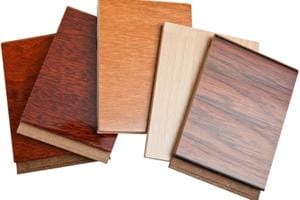 Engineered
Engineered
Engineered hardwood planks combine an actual wood surface with a solid plywood base. The solid base provides more durability, made for environments with varying humidity. Boards can be glued to concrete or on an acoustic membrane – even with radiant heating. Boards can also be stapled to a plywood subfloor for condos, basements, and commercial settings. There are a few factors to consider when choosing engineered hardwood flooring:
-
The thickness of the hardwood layer
-
Number of layers or plywood plies
-
The process used to cut the hardwood surface
-
The precision of the cut of the base layers
Look for a wear layer (the hardwood layer) with a thickness of 5/32″ (4mm) or more. Try to look for a wear layer that has been dry saw cut as opposed to rotary peeled or slice cut. Dry saw cut engineered hardwood creates a high-quality hardwood layer with a genuinely natural look. Keep your eye on how many plies as well. To ensure good floor stability, you want at least five plywood plies.
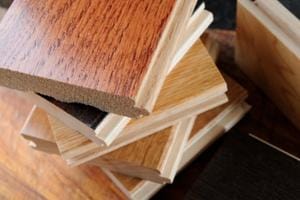 Solid
Solid
Solid hardwood boards are just that, solid hardwood. These boards are generally about 3/4″ (19 mm) thick. You can purchase it unfinished or prefinished:
-
Unfinished wood comes as raw, unfinished boards. After installing the floor, the installer sands the wood and begins finishing it by applying a layer of stain and several coats of varnish to protect it. However, the on-site finish is not nearly as durable as a factory-applied finish. Guarantees on unfinished hardwood only cover installation and exclude wear and tear.
-
Prefinished solid hardwood is ore-sanded, stained, and finished in a controlled environment. This factory-applied protection makes the solid hardwood flooring ready to go right out of the box. It makes installation more manageable, less time-consuming, and avoids the varnish odors you can’t evade when finishing is done on-site. Another plus, you won’t need to wait for anything to dry before walking or putting furniture back after the installation.
SPECIES
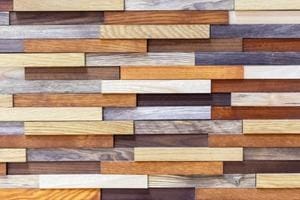 Each species of wood has a distinguishable grain, color, and texture. The best-known and most widespread species are red oak and maple, followed by white oak, hickory, and walnut. Individual taste and preference guide us in choosing one species over another. Your room’s décor and your desired outcome will impact your decision. Some customers are attracted to the warmth and richness of higher-end exotic hardwood species like tigerwood, Brazilian cherry, African mahogany, or maybe an Australian Cypress.
Each species of wood has a distinguishable grain, color, and texture. The best-known and most widespread species are red oak and maple, followed by white oak, hickory, and walnut. Individual taste and preference guide us in choosing one species over another. Your room’s décor and your desired outcome will impact your decision. Some customers are attracted to the warmth and richness of higher-end exotic hardwood species like tigerwood, Brazilian cherry, African mahogany, or maybe an Australian Cypress.
WOOD GRADES
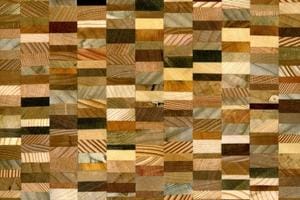 The grade of wood is used to classify the general appearance of the wood’s natural color and markings. This does not have anything to do with what type of quality it is, just the visual aspect of the wood. There are three grades:
The grade of wood is used to classify the general appearance of the wood’s natural color and markings. This does not have anything to do with what type of quality it is, just the visual aspect of the wood. There are three grades:
-
Select and Better: Wood planks with the most uniform natural coloration.
-
Exclusive: Wood planks with pronounced and nuanced colors
-
Character: Wood planks with unlimited natural characteristics like knots, mineral streaks, cracks, surface holes, and other milling marks.
Examining a few boards from the same box will confirm if the products are accurately categorized and reveal if there are any production irregularities. Some manufacturers use third-category grades to accommodate substantial manufacturing and finishing imperfections and sell these products without a guarantee.
Manufacturers have created techniques to recreate the rustic appearance of floors of the olden days. Their methods alter the coloring and finishing on panels to simulate the passage of time, resulting in planks with large knots and an aged appearance.
TEXTURES
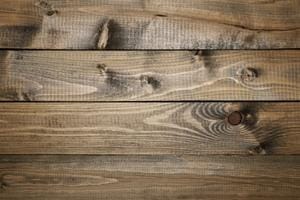 Some flooring manufacturers use scratch-resistant finishes along with stains that give the appearance of distressed wood or a brushed finish to make it easier to conceal signs of day-to-day wear. These floors are an excellent option for active families and pet owners.
Some flooring manufacturers use scratch-resistant finishes along with stains that give the appearance of distressed wood or a brushed finish to make it easier to conceal signs of day-to-day wear. These floors are an excellent option for active families and pet owners.
FINISHES
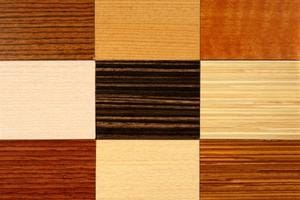 After you have explored all your options and settled on the type of hardwood you want, there are still more decisions to make. You’ll need to determine your floor’s color, the width of boards you want to use, and the finish. These will all depend on what kind of look you’re going for. An installed hardwood floor will last a long time, so it deserves careful consideration.
After you have explored all your options and settled on the type of hardwood you want, there are still more decisions to make. You’ll need to determine your floor’s color, the width of boards you want to use, and the finish. These will all depend on what kind of look you’re going for. An installed hardwood floor will last a long time, so it deserves careful consideration.
-
Color – Hardwood floors have traditionally been seen as nothing more than building materials. Nowadays, they’re a critical decorative element with contrasting and multi-tone colors available in flooring that comes prefinished.
-
Width – Planks come in 2-¼” to 7-¾” widths. The board’s width is a matter of preference, the type of wood, and the effect you want to create. Narrower boards can make a room seem more profound, whereas larger boards will do the opposite.
-
Gloss – Products currently on the market fall into one of four categories:
-
High-gloss – Gleaming, smooth surface that reflects much light but tends to amplify marks and scratches.
-
Semi-gloss – A medium shine, the most common for prefinished floors.
-
Matte – A satin or completely matte finish that reduces the appearance of marks and scratches.
-
Ultra-matte – A highly matte finish that looks like oiled hardwood floors.
-
TIP – The more people living in the house, the bigger the considerations on durability need to be. For example, large families will increase the amount of wear. Matte or satin finishes and textured floors forgive many more accidental scratches that come with small children and pets.
INSTALLATION
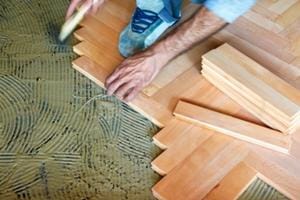 When buying a hardwood flooring, it’s worth taking the time to find a professional installer that you’re confident in. Not only because of the significant investment but also because installation work is often considered challenging and should not be your responsibility. There is no risk of you getting it wrong if you plan to hire a professional company.
When buying a hardwood flooring, it’s worth taking the time to find a professional installer that you’re confident in. Not only because of the significant investment but also because installation work is often considered challenging and should not be your responsibility. There is no risk of you getting it wrong if you plan to hire a professional company.
-
Type of Home – The type of residence will significantly influence the flooring type and installation method you need. In a single-family home, the subfloor dictates the kind of floor you can install. In a condo, your condo owner’s agreement usually has soundproofing rules that you must consider. Generally, an engineered floor will be your best option in a basement.
-
Board Direction – Do you want your floorboards installed in a straight line along the length or width of the room or in a pattern? Aesthetics and personal taste will determine your choice of board direction. When installing boards on a wood subfloor, it is best to position them perpendicular to the joists. Similarly, you should pay attention to optical illusions—it’s better, for instance, to avoid placing boards widthwise in a long, narrow room. If you’re looking for a unique look, opt for a herringbone floor, where you arrange fixed-length boards into geometric patterns like herringbone, bricks, cube, and basket.
-
Accessories – You will also need accessories to join the room with the walls and stair nosing. The right retailer will find out if these things are available in the same stain, gloss, and species as your floor.
MAINTENANCE
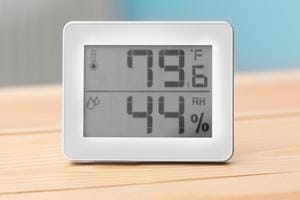 Hardwood floors are typically more durable and stable than other floorings, but you still need to avoid water, soap, and sand. You should not use excess water, soak mops in water, or use commercial soaps on your hardwood floor. Regular vacuuming, a damp cloth, and a manufacturer-recommended cleaner are all you need to keep your hardwood floor looking good.
Hardwood floors are typically more durable and stable than other floorings, but you still need to avoid water, soap, and sand. You should not use excess water, soak mops in water, or use commercial soaps on your hardwood floor. Regular vacuuming, a damp cloth, and a manufacturer-recommended cleaner are all you need to keep your hardwood floor looking good.
It is also crucial to pay attention to humidity levels in your home. Although hardwood flooring is very durable, moisture can cause the wood to warp or lift and nails to come loose. Manufacturers recommend keeping humidity levels at around 45% to prevent unfavorable conditions for your wood floors and make your house more comfortable.
SUM IT UP
Hardwood has some qualities that are unmatched by other floor coverings. Hardwood floors are natural, environmentally friendly, attractive, and easy to maintain. They instantly make any home feel warm and cozy while increasing the value of your property. Hardwood floors help create a healthier and cleaner home environment since they prevent pesky allergens from all floating in the air.
When deciding on flooring for your home, it’s essential to take the process seriously. This will give you peace of mind and a return on investment that can increase your home value. The retailer you choose is just as important as your choice of flooring. The retailer is also your advisor. At Creative Carpet & Flooring, our Flooring Consultants dedicate themselves to finding the best possible product to meet your needs, and their advice is knowledgeable and helpful.
